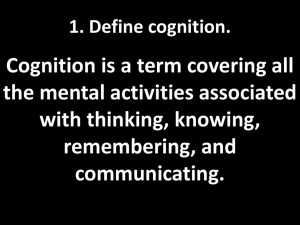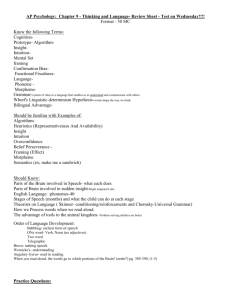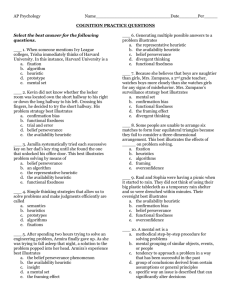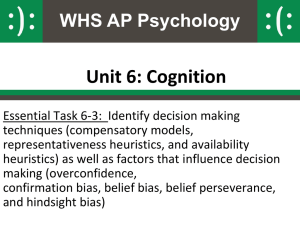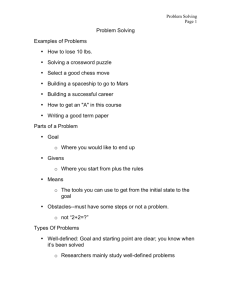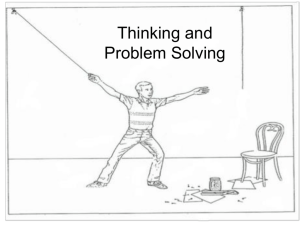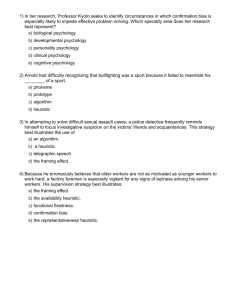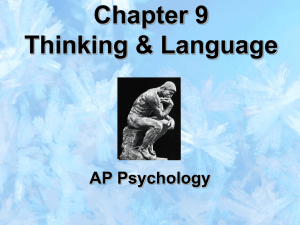File - Mrs. Hults' Class
advertisement
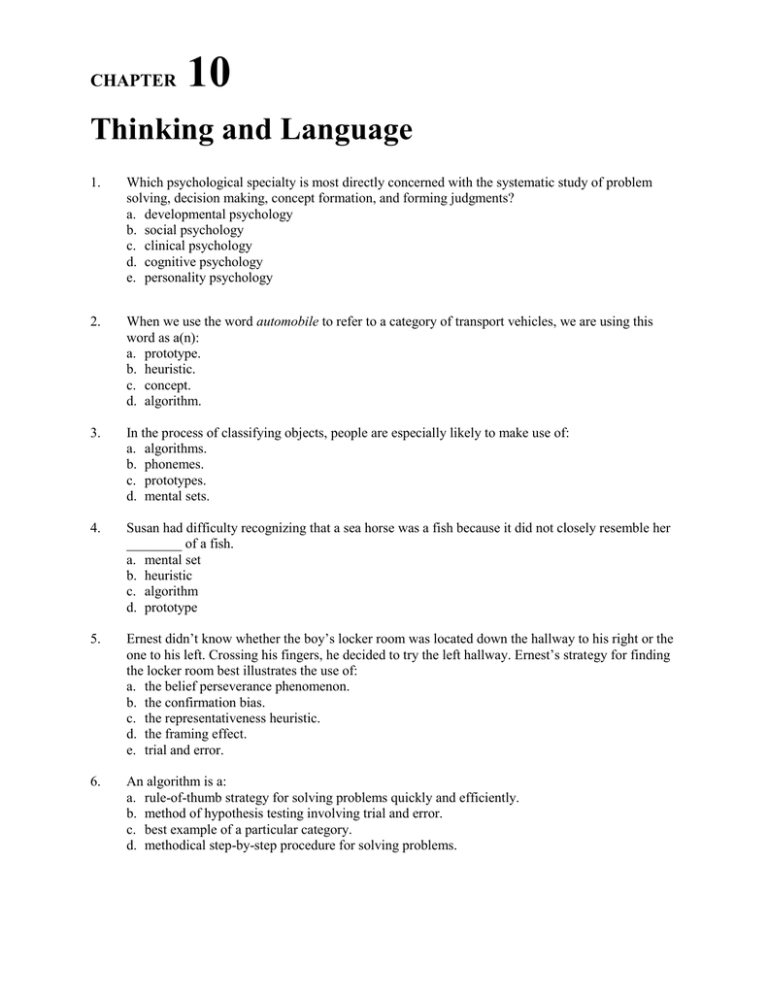
CHAPTER 10 Thinking and Language 1. Which psychological specialty is most directly concerned with the systematic study of problem solving, decision making, concept formation, and forming judgments? a. developmental psychology b. social psychology c. clinical psychology d. cognitive psychology e. personality psychology 2. When we use the word automobile to refer to a category of transport vehicles, we are using this word as a(n): a. prototype. b. heuristic. c. concept. d. algorithm. 3. In the process of classifying objects, people are especially likely to make use of: a. algorithms. b. phonemes. c. prototypes. d. mental sets. 4. Susan had difficulty recognizing that a sea horse was a fish because it did not closely resemble her ________ of a fish. a. mental set b. heuristic c. algorithm d. prototype 5. Ernest didn’t know whether the boy’s locker room was located down the hallway to his right or the one to his left. Crossing his fingers, he decided to try the left hallway. Ernest’s strategy for finding the locker room best illustrates the use of: a. the belief perseverance phenomenon. b. the confirmation bias. c. the representativeness heuristic. d. the framing effect. e. trial and error. 6. An algorithm is a: a. rule-of-thumb strategy for solving problems quickly and efficiently. b. method of hypothesis testing involving trial and error. c. best example of a particular category. d. methodical step-by-step procedure for solving problems. 7. A chess-playing computer program that routinely calculates all possible outcomes of all possible game moves best illustrates problem solving by means of: a. the availability heuristic. b. belief perseverance. c. an algorithm. d. the representativeness heuristic. e. functional fixedness. 8. The use of heuristics rather than algorithms is most likely to: a. save time in arriving at solutions to problems. b. yield more accurate solutions to problems. c. minimize the overconfidence phenomenon. d. involve greater reliance on language skills. 9. As he attempted to spell the word receive, Elmer reminded himself “i before e except after c.” Elmer’s self-reminder best illustrates the use of: a. a prototype. b. trial and error. c. insight. d. an algorithm. e. a heuristic. 10. After spending 2 hours trying to solve an engineering problem, Amira finally gave up. As she was trying to fall asleep that night, a solution to the problem popped into her head. Amira’s experience best illustrates: a. the belief perseverance phenomenon. b. the availability heuristic. c. insight. d. the framing effect. e. confirmation bias. 11. The confirmation bias refers to the tendency to: a. search for information consistent with our preconceptions. b. judge the likelihood of events on the basis of how easily we can remember examples of them. c. overestimate the accuracy of our beliefs and judgments. d. overestimate the degree to which other people will confirm our beliefs. 12. Because she believes that boys are naughtier than girls, Mrs. Hill, a second-grade teacher, watches boys more closely than girls for any signs of misbehavior. Mrs. Hill’s surveillance strategy best illustrates: a. the availability heuristic. b. confirmation bias. c. functional fixedness. d. the representativeness heuristic. e. the framing effect. 13. The inability to take a new perspective on a problem is called a: a. confirmation bias. b. fixation. c. heuristic. d. framing effect. e. prototype. 14. The tendency to think of objects only in terms of their normal uses is called: a. functional fixedness. b. the availability heuristic. c. confirmation bias. d. belief perseverance. e. the representativeness heuristic. 15. Miss Jan De Jong is orderly, neat, fairly quiet, and shy. She enjoys reading in her spare time and belongs to a social club that includes three librarians, nine real estate agents, and eight social workers. A tendency to conclude that Jan must be one of the three librarians would illustrate the powerful influence of: a. confirmation bias. b. the framing effect. c. the representativeness heuristic. d. the belief perseverance phenomenon. e. the availability heuristic. 16. Isabel suffered symptoms so similar to those associated with pregnancy-induced morning sickness that she erroneously concluded that she was pregnant. Isabel’s conclusion best illustrates the influence of: a. confirmation bias. b. the availability heuristic. c. the representativeness heuristic. d. functional fixedness 17. Our tendency to judge the likelihood of an event on the basis of how readily we can remember instances of its occurrence is called the: a. framing effect. b. belief perseverance phenomenon. c. confirmation bias. d. representativeness heuristic. e. availability heuristic 18. Paul overestimates the proportion of family chores for which he takes sole responsibility because it’s easier for him to recall what he has done than to recall what other family members have done. This best illustrates the impact of: a. overconfidence. b. functional fixedness. c. the representativeness heuristic. d. confirmation bias. e. the availability heuristic. 19. The overconfidence phenomenon refers to the tendency to: a. cling to our initial conceptions, even though they have been discredited. b. search for information consistent with our preconceptions. c. underestimate the extent to which our beliefs and judgments are erroneous. d. judge the likelihood of an event in terms of how readily instances of its occurrence are remembered. 20. Stockbrokers often believe that their own expertise will enable them to select stocks that will outperform the market average. This belief best illustrates: a. functional fixedness. b. confirmation bias. c. the framing effect. d. the availability heuristic. e. overconfidence. 21. Consumers respond more positively to ground beef advertised as “75 percent lean” than to ground beef described as “25 percent fat.” This illustrates that consumer reactions are influenced by: a. the representativeness heuristic. b. the belief perseverance phenomenon. c. confirmation bias. d. the availability heuristic. e. framing. 22. On Monday, the meteorologist forecast a 20 percent chance of rain, so Sheryl took her umbrella to work. On Friday, he reported an 80 percent chance that it would not rain, so Sheryl left her umbrella at home. Sheryl’s behavior illustrates: a. confirmation bias. b. the belief perseverance phenomenon. c. overconfidence. d. the representativeness heuristic. e. the framing effect. 23. People with opposing views of capital punishment reviewed mixed evidence regarding its effectiveness as a crime deterrent. As a result, their opposing views differed more strongly than ever. This best illustrates: a. the framing effect. b. functional fixedness. c. the representativeness heuristic. d. the belief perseverance phenomenon. e. the availability heuristic. 24. Research findings suggest that the best advice to give people who want to avoid belief perseverance is: a. “Try to justify your positions.” b. “Consider the opposite.” c. “Don’t draw hasty conclusions.” d. “Consider the objective evidence.” 25. The smallest distinctive sound unit of language is a: a. prototype. b. phenotype. c. morpheme. d. phoneme. 26. Morphemes are: a. the smallest speech units that carry meaning. b. the best examples of particular categories of objects. c. the smallest distinctive sound units of a language. d. rules for combining words into grammatically correct sentences. 27. Semantics refers to the: a. logical and methodical procedures for solving problems. b. orderly arrangement of words into grammatically correct sentences. c. rule-of-thumb strategies that facilitate quick decision making. d. derivation of meaning from morphemes, words, and sentences. 28. The rock musician was HIT with a rotten egg while performing his latest HIT song. The fact that you can recognize two different meanings for the word “hit” in the preceding sentence demonstrates the importance of: a. syntax. b. semantics. c. morphemes. d. prototypes. e. linguistic relativity. 29. In order to combine words into grammatically sensible sentences, one needs to adhere to proper rules of: a. semantics. b. syntax. c. nomenclature. d. phonics. 30. The earliest stage of speech development is called the ________ stage. a. babbling b. telegraphic speech c. one-word d. grammatical e. semantic 31. At the age of 15 months, Carla repeatedly cries “hoy” when she wants her mother to hold her. Carla is most likely in the ________ stage of language development. a. syntactic b. babbling c. telegraphic speech d. echoic e. one-word 32. The best evidence that there is a critical period for language acquisition is the fact that: a. infants babble phonemes that do not occur in their parents’ native language. b. toddlers maintain a capacity to discriminate phonemes that they have never heard. c. people most easily master the grammar of a second language during childhood. d. preschoolers often overgeneralize certain rules of grammatical structure. 33. Whorf’s linguistic relativity hypothesis emphasizes that: a. infancy is a critical period for language development. b. the grammatical rules of a language are constantly changing. c. our social status influences our linguistic proficiencies. d. language determines the way we think. 34. Research with children indicates that the use of the generic pronoun “he” tends to trigger images of: a. a male. b. a female about a third of the time the pronoun is used. c. a female about half the time the pronoun is used. d. persons who are neither obviously male nor obviously female. 35. The fact that we can think without language is best illustrated in research on: a. mental imagery. b. functional fixedness. c. the framing effect. d. algorithms. e. the representativeness heuristic.
